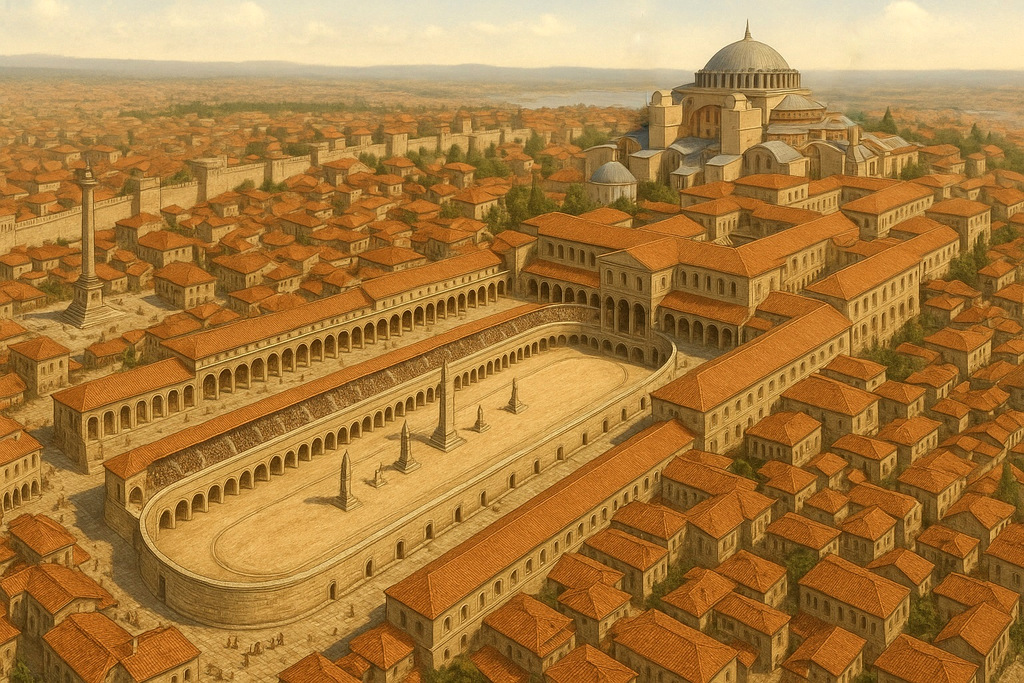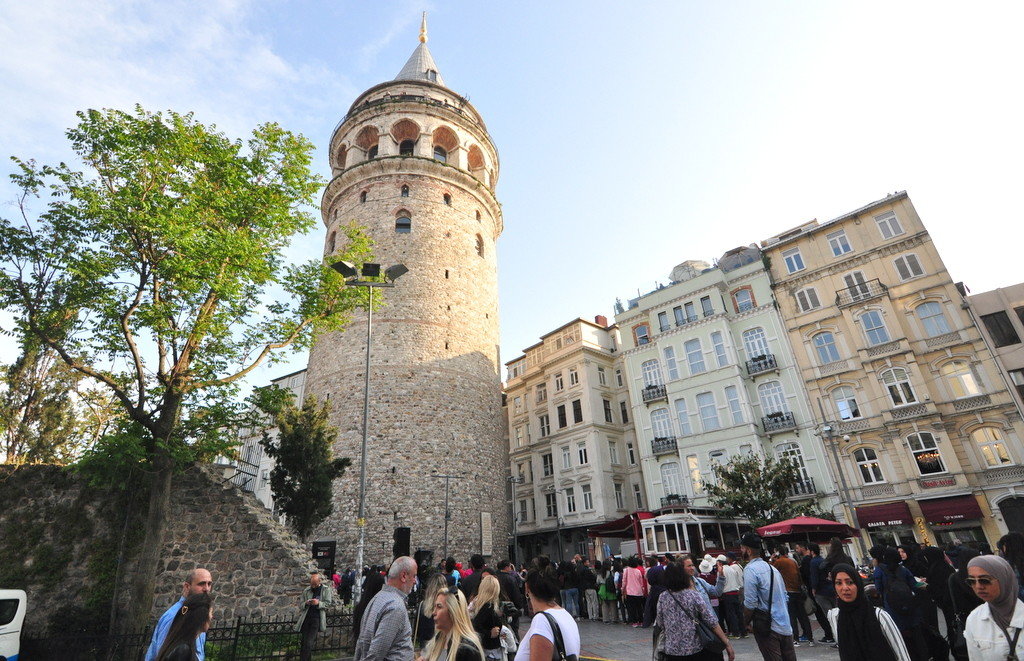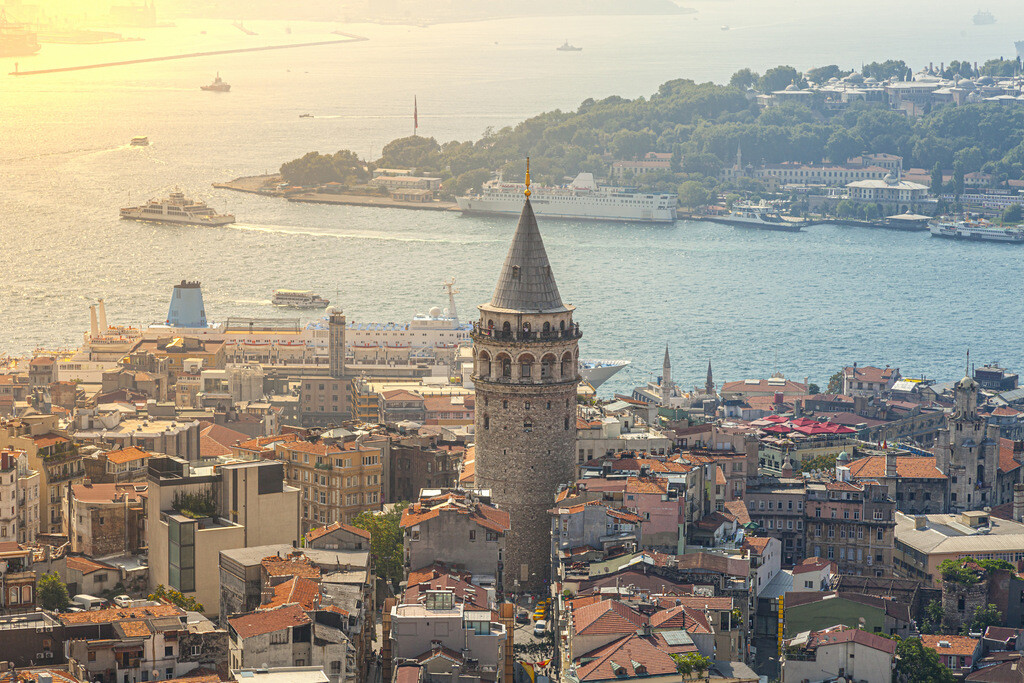Where the rooftops of old Istanbul meet the seagulls and sky, Galata Tower rises like a storybook sentinel. Built by Genoese merchants, crowned by Ottoman watchmen, and now embraced by selfie-takers from around the globe — this stone giant has watched empires rise, ships sail, and dreams take flight.
Climb its spiral stairs or glide up the elevator, and you’ll find one of the most breathtaking panoramas in the city: minarets, domes, and the silver thread of the Bosphorus stretching into two continents. But Galata is more than a view — it’s a time capsule of Istanbul’s restless soul.
As a licensed tour guide who has walked these cobblestone streets with curious travelers for over two decades, I created this blog to help you explore Istanbul with depth and delight. In this guide, I’ll share everything you need to know about visiting Galata Tower in 2025 — from ticket options and opening hours to the secret stories carved into its ancient stone.
📌 Galata Tower 2025 Visitor Summary
A practical guide to visiting Galata Tower in 2025 — updated ticket prices, hours, and quick tips!
🏷️ Ticket Price: 30 Euros for foreign visitors
⏰ Opening Hours: 08:30 – 23:00 (last entry: 22:00)
🙏 Closed: Open every day
🎫 Museum Pass: ✅ Valid at Galata Tower
🚀 Skip-the-line: Online ticket recommended (you can book from the blue link below)
📍 Location: Galata, Beyoglu, Istanbul
📅 Last Updated: December 2025
Insider’s Note: Galata Tower Square gets very crowded in the afternoon, especially during peak seasons. This means long lines at the ticket booth and lots of people around the tower. If you want to explore the site peacefully and take great photos without bumping shoulders, I recommend arriving early in the morning. It’s the quietest time—and the lighting is perfect too!
The History of the Galata Tower
In order to tell the history of Galata Tower properly, we will have to rewind a little and touch on the history of Istanbul. Istanbul was once the second capital of the Roman Empire as Constantinople.
1. Foundation of Constantinople

It was a huge surprise for everyone when Emperor Constantine decided to move the capital of Roman Empire to a small city, called as Byzantium. However, Constantine’s move of the capital to the east was based on some realistic observations and had practical reasons.
The first of these was that Rome had lost its former strategic importance. Constantine wanted to be equidistant from the Germanic tribes and the Persians, who were Rome’s two great enemies. Istanbul was located exactly in such a place.
Byzantium, which was a small Ancient Greek colony at that time, had the potential to become the main commercial port of the Eastern Mediterranean in the future. Constantine the Great foresaw this opportunity.
Istanbul, which will be a bridge between the trade extending from Asia to Europe, would feed the empires (Byzantine and Ottoman) for centuries with this wealth.
Constantine moved the capital from Rome to Byzantium in 330 for this purpose. In the early years, the city was called “New Rome”. Later, the city was renamed Constantinople in honor of its founder.
After the foundation of Constantinople, Roman emperors began to live in the east. Emperor Constantine and the emperors who followed him positioned the center of Rome in the Eastern Mediterranean, a promising commercial center.
2. Italian Trade Colonies
As a matter of fact, Istanbul became the most important trade port in the world in a couple of centuries. Silk and spices from Asia were collected in the Port of Constantinople and distributed to Europe from there. Venetians and Genoese were at the head of this commercial system.
Settling of Venetian and Genoese colonies to Istanbul traces back to Byzantine Empire era. When Constantinople was just today’s Historical Peninsula, Italian trade colonies were established on the opposite shore of the Golden Horn (Galata).
Although relations between the Catholic Italian colonies and Orthodox Constantinople have had ups and downs throughout history, this trading system has persisted through the centuries.
As it is shown on the visual, Istanbul was only restricted to modern-day Historical Peninsula. At the opposite shore of the Golden Horn was Galata trade colony standing, surrounded with walls.
Those ancient walls surrounding Galata were, unfortunately, torn down due to municipal operations in the late Ottoman period.
3. Sack of Constantinople
However, at a specific time in history, one of the two Italian colonies broke up with Constantinople. During the Fourth Crusade, the Doge of Venice named Enrico Dandolo plundered Constantinople (1204). During the Sack of Constantinople, the local Venetian colony also cooperated with the invaders.
Catholics founded Latin Empire in Constantinople that lasted 57 years. (1204-1261) When the city was recaptured in 1261, Byzantines received a huge support from Genoese colonies. In return, they consigned a harbor district, known as Galata (today’s Karakoy district), to them.
4. Construction of the Galata Tower

The Genoese surrounded the Galata district, which was given to them, with walls. The construction of the Galata Tower was started to protect and monitor the port of Constantinople.
Of course, when the Byzantine Empire was strong, such a military structure would not be allowed in the heart of the capital. However, declining Byzantium needed the military assistance of the Genoese.
The Genoese remained loyal to Byzantium in return for the great privileges given to them. Thus, Yoros Castle and Galata Tower were built to protect the Bosphorus. You can see the castle near the Black Sea coast when you go on a Bosphorus cruise.
5. Fall of Constantinople
Though previous Ottoman rulers attempted to conquer the city multiple times, it was Mehmed II who succeeded in taking the city. Capture of the Galata Tower and the district was delayed due to the defense chain that was placed at the mouth of Golden Horn during the siege.
Byzantines and Genoese defended the city together against the siege because population was very low in the 15th century in Constantinople and the Empire needed every one of its soldiers to hold the city.
Call for aid to the Western Europe by Byzantine Emperor was in vain. Genoese Republic was the only state that came to assist the Byzantine Empire. They sent 700 soldiers under Giovanni Giustiniani’s command.
Giustiniani played a big role in organizing the defense of the city. The fall of the city was delayed because of his strategic genius. After he was injured, he noticed the inevitable ending and left the city.
In his absence, there was nothing to prevent the fall of Constantinople from happening, so the Ottomans conquered the city on May 29th, 1453. The Galata Tower was handed down to the Sultan Mehmed II on the same day.
6. Commercial Privileges to Trading Colonies
Mehmed the Conqueror was a very realist and practical ruler. He was unwilling to damage the trade route that had brought precious goods and great deal of money for centuries. For that reason, he let the traditional trade route continue to perform.
Sultan granted some commercial privileges to Venetian and Genoese trading colonies and they continued to act as a tie between Constantinople and Europe. Of course, the Ottoman Empire made money via high taxes.
Galata Tower Entrance Fee 2025
Galata Tower entrance fee is 30 Euros in 2025. The ticket includes access to the observation terrace with panoramic views of Istanbul. Museum Pass Istanbul is accepted at the entrance. This information was last updated on December 12, 2025.
🎟️ Skip the Line at Galata Tower
Want to enjoy the amazing views from Galata Tower without waiting in line? Below are two great options: one for fast-track entry with audio guide, and another for seeing the tower from the water on a private Bosphorus cruise.
Top-rated experiences • Mobile tickets • Instant confirmation
Galata Tower Opening Hours 2025
In 2025, Galata Tower is open daily from 08:30 AM to 11:00 PM. There are no closing days, and the tower remains open all year round. This information was last updated on December 12, 2025.
During the summer months, Galata Tower may host different events in the evenings as part of “Night Museology”. For this reason, opening hours may also change; for example, these days the tower is closed between 18:15 and 19:00 for evening preparations.
Visiting times of museums in Istanbul may change due to events and renovations. Before going to the museum, I suggest you visit the official website of the museum and review the latest situation.
Insider’s Note: After an extensive restoration, the Galata Tower is no longer just a place to snap skyline photos from the top. Today, it feels more like a small museum — offering a journey through the city’s layered past. If you’re curious about Istanbul’s history, be sure to take your time inside and explore all the floors!
How to Get to the Galata Tower?

Galata Tower rises from the heart of Istanbul’s Beyoğlu district like a timeless sentinel — its conical roof piercing the sky, its stone body wrapped in stories. Tucked within the charming Galata quarter, this medieval tower is surrounded by a maze of cobbled streets, trendy cafés, and the echoes of Genoese merchants who once called this hilltop home.
Reaching the tower can be an adventure in itself, depending on where you’re coming from — but don’t worry, it’s all part of the experience.
Insider’s Note: The uphill path to Galata Tower is part of the charm, but it’s also cobbled and can be steep. If you or your travel companions have mobility concerns, it’s best to take a taxi up to Galata Square and enjoy the final (and flatter) stretch on foot.
From Sultanahmet or the Old City
If you’re starting from Sultanahmet (home to Hagia Sophia and Topkapi Palace), the easiest route is to take Tram T1 toward Kabatas. Ride it to Karaköy Station — the journey takes about 20–25 minutes. Once you exit at Karaköy, the tower is just a 10-minute uphill walk.
Walk across the Yuksek Kaldirim Street and follow the signs toward Galata Kulesi. The final stretch involves a scenic but steep incline through historic alleys — so wear comfortable shoes and pause for a simit or fresh juice on the way up.
Or, if you prefer a shortcut, hop on the historic Tünel funicular (from Karaköy to Beyoğlu). It’s the world’s second-oldest underground railway and drops you off just a 5-minute walk from the tower.
From Taksim Square
From Taksim, Walk down İstiklal Avenue, the city’s iconic pedestrian boulevard filled with boutiques, bakeries, churches, and galleries. When you reach around Tunel area, follow the signs toward Galata Tower — it’s just a few minutes downhill from there.
Coming by Ferry?
If you’re arriving from the Asian side (like Kadıköy or Üsküdar), take a ferry to Karaköy or Eminönü, then walk or take the tram across to Karaköy. From there, follow the same uphill route through Galata’s vibrant backstreets to reach the tower.
Then don’t miss these other unforgettable landmarks across Istanbul — each one revealing a different layer of the city’s remarkable story:
- Hagia Sophia – A timeless marvel that bridges empires and faiths
- Topkapi Palace – The imperial residence of Ottoman sultans for 400 years
- Dolmabahce Palace – A dazzling 19th-century palace on the Bosphorus
- Blue Mosque – An iconic masterpiece of Ottoman architecture and faith
- Basilica Cistern – Discover the mysterious world beneath the Old City
Things to Do around Galata Tower
You can see hundreds of people around Galata Tower during the day. The square under the tower is called “Kuledibi” in the local language. There are many cafes, restaurants and shopping streets around. We can summarize the things to do around Galata Tower in a few titles.
1. Galata Mevlevi House Museum
Galata Mevlevi House Museum was the spiritual center of whirling dervishes. Whirling Dervish Show, one of the most beautiful theatrical performances in Istanbul, is also performed here.
Galata Mevlevi House Museum is a museum affiliated to the Ministry of Culture and Tourism and if you have Museum Pass Istanbul, you can enter here for free.
2. Istiklal Street

After visiting the Mevlevi Museum, you can go to Tunnel Square with just a few minutes’ walk. Tunnel is the beginning of Istiklal Street, which stretches for 1.5 kilometers.
Istiklal Street is the most enjoyable walking street in Istanbul. It starts with Tunnel Square and continues until Taksim Square. You can see restaurants, cafes and shopping places along the street.
3. Serdar-i Ekrem Street
Serdar-i Ekrem Street is a shopping street whose popularity has increased in recent years. You can find shops selling specially designed items on this street. There are also stylish boutique hotels and cafes.
4. Galataport
Galataport is a huge complex serving as Istanbul’s cruise port. There are many options for both shopping and eating here. You can reach Galataport with a 15-minute walk from the tower.
5. Nardis Jazz Club
Nardis Jazz Club is among the best clubs in Istanbul, hosting local and foreign jazz artists. The club is located a few minutes from the tower.
Conclusion
Galata Tower isn’t just a viewpoint — it’s a moment suspended between earth and sky. From its stone crown, you don’t just see Istanbul; you feel it — the domes and minarets, the shimmer of the Golden Horn, the whispers of past centuries caught in the breeze.
After taking in the view, wander down through the cobbled lanes of Galata and Karaköy, where bohemian cafés, street murals, and artisan shops blend old Istanbul with its modern heartbeat.
For a deeper taste of the neighborhood, step into Kamondo Stairs, an architectural curiosity with a story of its own, or follow the road to Tünel, the world’s second-oldest underground railway. From there, the Istiklal Avenue opens before you — a bustling pedestrian street filled with music, history, and surprises around every corner.
Whether you climb the tower at dawn or dusk, Galata offers more than just a view — it offers perspective. A reminder that in Istanbul, every height reached tells a story worth hearing.
Written by Serhat Engul
I couldn’t find updated opening information on their website, may I ask how you heard of the reopening? Is there any way to purchase tickets online now? Thank you!
The opening or closing of museums in Istanbul due to restoration is notified to guides in the city via email by the Istanbul Guides Chamber. Otherwise, thousands of tours would be disrupted.
I received information from official sources as I mentioned, but any local or foreign tourist can see that the museum is currently open to visitors on a limited basis from this official website.
I don’t understand why you can’t see it, maybe you are looking at the wrong site. Unfortunately, I don’t know how to buy tickets online right now.
Hi Serhat,
I will be in Istanbul at the end of this month.
Will it be possible to visit the Galata Tower Museum?
Thanks
Hello Claudia, I’m afraid Galata Tower will be closed for a while due to roof restoration. It is not yet clear when it will open, but I estimate it will open in the fall.
If I were you, I would research the rooftop cafes around the Galata Tower and go to one of them to take photos. Photographing the tower with the view from a high place is better than climbing the tower itself.
Is the tower renovation complete ? We are visting Istanbul in the first week of May, 2024.
Hello Vaibhav,
Unfortunately, the restoration of the tower is not finished yet. Building reinforcement works are continuing and unfortunately I do not think Galata Tower will be opened in the next few weeks.
Have a nice trip!